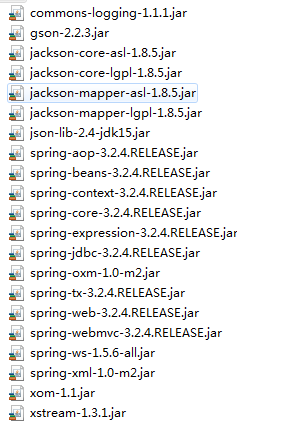SpringMVC简单构造restful, 并返回json
文章要要点:
快速搭建构造restful的StringMvc
GET, POST , PUT , DELETE的各种调用
同一资源 多种表述 (ContentNegotiatingViewResolver解析器),既可以返回对象给JSP, 也可以返回JSON
快速搭建构造restful的StringMvc
首现搭建一个简单的restfulMvc框架, 并上配置文件, 后期会增加带JSON返回值的配置
JAR包

web.xml配置
<servlet> <servlet-name>spring</servlet-name> <servlet-class>org.springframework.web.servlet.DispatcherServlet</servlet-class> <!-- 可以自定义servlet.xml配置文件的位置和名称,默认为WEB-INF目录下,名称为[<servlet-name>]-servlet.xml,如spring-servlet.xml--> <init-param> <param-name>contextConfigLocation</param-name> <param-value>classpath:config/spring-servlet.xml</param-value><!-- 现定义为src下config包里(个人习惯) --> </init-param> <load-on-startup>1</load-on-startup> </servlet> <servlet-mapping> <servlet-name>spring</servlet-name> <url-pattern>/api/*</url-pattern> </servlet-mapping> <!-- Spring配置 --> <listener> <listener-class>org.springframework.web.context.ContextLoaderListener</listener-class> </listener> <!-- 指定Spring Bean的配置文件所在目录。默认配置在WEB-INF目录下 --> <context-param> <param-name>contextConfigLocation</param-name> <param-value>classpath:config/applicationContext-*.xml</param-value> </context-param>
spring-servlet.xml配置
<!-- 启动注解驱动的Spring MVC功能,注册请求url和注解POJO类方法的映射--> <mvc:annotation-driven /> <!-- 启动包扫描功能,以便注册带有@Controller、@Service、@repository、@Component等注解的类成为spring的bean --> <context:component-scan base-package="com.dsp" /> <!-- 对模型视图名称的解析,在请求时模型视图名称添加前后缀 --> <bean class="org.springframework.web.servlet.view.InternalResourceViewResolver" p:prefix="/WEB-INF/jsp/" p:suffix=".jsp" />
applicationContext.xml暂时没写东西
该配置的配置完了,下面就是写第一个HelloWord
package com.dsp.action;
import javax.servlet.http.HttpServletRequest;
import javax.servlet.http.HttpServletResponse;
import org.springframework.context.annotation.Scope;
import org.springframework.stereotype.Controller;
import org.springframework.web.bind.annotation.RequestMapping;
import org.springframework.web.bind.annotation.RequestMethod;
@Scope("prototype")//单列模式
@Controller
@RequestMapping("/products")
public class TestController{
/**
* 测试方法,HelloWord
* @param request
* @param response
* @return
* @throws Exception
*/
@RequestMapping(value="/list",method=RequestMethod.GET)
public String getProducts(HttpServletRequest request,HttpServletResponse response) throws Exception {
request.setAttribute("name", "helloWord");
return "products/list";
}
}
@Scope("##") : spring默认的Scope是单列模式(singleton),顾名思义,肯定是线程不安全的. 而@Scope("prototype")
可以保证每个请求都会创建一个新的实例, 还有几个参数: session request
@Scope("session")的意思就是,只要用户不退出,实例就一直存在,
request : 就是作用域换成了request
@Controller : 不多做解释 , 标注它为Controller
@RequestMapping :是一个用来处理请求地址映射的注解,可用于类或方法上。用于类上,表示类中的所有响应请求的方法都是 以该地址作为父路径。 比如现在访问getProducts方法的地址就是 :
http://localhost:8080/项目名/上面web.xml配置(api)/products/list
l
暂时先介绍两个属性 value和method
具体可以参考我参考的文章 http://blog.sina.com.cn/s/blog_72827fb10101pl9i.html
value: 就是映射的实际地址,这个上面有说过, 而重要的是里面的值 , 有几个比较感兴趣的
1. 正常的 /list 访问地址类似 http://localhost:8080/项目名/api/products/list
2. 带参数的 /info/{proId} 访问地址类似 http://localhost:8080/项目名/api/products/info/0001
method: 请求的method类型 GET POST PUT DELETE等
好,做个测试 JSP代码:
<%@ page language="java" contentType="text/html; charset=UTF-8"
pageEncoding="UTF-8"%>
<!DOCTYPE html PUBLIC "-//W3C//DTD HTML 4.01 Transitional//EN" "http://www.w3.org/TR/html4/loose.dtd">
<html>
<head>
<meta http-equiv="Content-Type" content="text/html; charset=UTF-8">
<title> 你好</title>
</head>
<body>
${name }
</body>
</html>
地址栏输入 http://localhost:8080/RestFulMvc/api/products/list
得到结果

连载中....
郑重声明:本站内容如果来自互联网及其他传播媒体,其版权均属原媒体及文章作者所有。转载目的在于传递更多信息及用于网络分享,并不代表本站赞同其观点和对其真实性负责,也不构成任何其他建议。





































